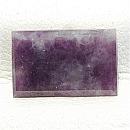|
|
||||||||||||||||
|
||||||||||||||||
|
||||||
|
|
|
|
Spurrite
|
|
| | |
| Discovered in 1908; IMA status: Valid (pre-IMA; Grandfathered) | ||
|
| ||
|
Chemistry |
|
|
| |
|
Ca5(SiO4)2(CO3) | |
|
|
Calcium Silicate Carbonate |
|
Molecular Weight: |
444.57 gm |
|
Composition: |
Calcium |
45.08 % |
Ca |
63.07 % |
CaO |
|
|
Silicon |
12.64 % |
Si |
27.03 % |
SiO2 |
|
|
Carbon |
2.70 % |
C |
9.90 % |
CO2 |
|
|
Oxygen |
39.59 % |
O |
|
|
|
|
|
100.00 % |
|
100.00 % |
= TOTAL OXIDE |
|
|
|
||||
|
Classification |
|
|
| |
|
Silicates | |
|
8/B.22-50 | |
|
|
9 : SILICATES (Germanates)
|
|
Related to: |
Dimorpous with Paraspurrite |
|
Members of Group: |
n/a |
|
Varieties: |
Paraspurrite |
|
Synonyms: |
None |
|
|
|
|
Crystal Data |
|
|
|
|
|
Anhedral crystalline, granular or massive. |
|
|
Polysynthetic twins on {001} and {101}, composition planes {001} or {205} |
|
|
|
|
|
Physical Properties |
|
|
|
|
|
Perfect on {001}, poor on {100}, (001) ^ (100) = 79° |
|
|
Uneven to Splintery |
|
|
Brittle |
|
|
5.0 |
|
|
3.02 (g/cm3) |
|
|
Green under SW UV; green cathodoluminescence |
|
|
Not Radioactive |
|
|
|
|
|
Optical Properties |
|
|
|
|
|
White to gray or lavender-gray, violet or purple; colorless in thin section |
|
|
Transparent to Translucent |
|
|
Vitreous to Resinous |
|
|
1.640 - 1.681 Biaxial ( - ) |
|
|
0.039 - 0.040 |
|
|
Relatively weak, crossed, distinct; r > v |
|
|
n/a |
|
|
n/a |
|
|
|
|
|
Occurances |
|
|
|
|
|
Geological Setting: |
A product of high-temperature thermal metamorphism along the contact between carbonate rock and mafic magma. |
|
Common Associations: |
Gehlenite, Merwinite, Tilleyite, Hillebrandite, Scawtite, Kilchoanite, Rankinite, Larnite, Foshagite, Wollastonite |
|
Common Impurities: |
Ti, Al, Fe, Mn, Mg, Na, K |
|
Type Locality: |
Terneras Mine, Velardeña, Velardeña District, Mun. de Cuencamé, Durango, Mexico |
|
Year Discovered: |
1908 |
|
View mineral photos: | |
|
|
|
|
More Information |
|
|
|
|
|
| |
|
|
|
|
Spurrite is a calcium silicate carbonte that is typically white to gray in color but may also be found in other colors such as lilac at the Negra Mine, Maconi, Mun. de Cadereyta, Querataro, Mexico; unusually bright violet-purple at the Fuka Mine, Takahashi City, Okayama Prefecture, Japan; bluish-gray at the Crestmore Quarries, Crestmore, Riverside County, California, USA; and lavender-gray from South Sisters Peak, Tres Hermanas District, Luna County, New Mexico, USA. Spurrite gives off a green cathodoluminescence when exposed to shortwave UV light. A unique characteristic of Spurrite is that it abides by two twin laws. Polysynthetic twinning can occur along its (001) axis and another type of twinning can occur parallel to its optical axes. Spurrite
is also found at Seekante, Mayener Feld, Southern lava flow, Bellerberg volcano, Ettringen, Mayen, Eifel, Rhineland-Palatinate, Germany;
Velardeña District, Mun. de Cuencamé, Durango, Mexico;
Carneal, Glenoe, Co. Antrim, Northern Ireland, UK; and
Christmas Mountains, Brewster County, Texas, USA. |
|
|
We
have not photographed our Spurrite gems. Please
check back soon. |
